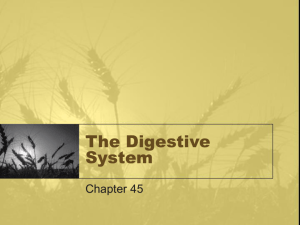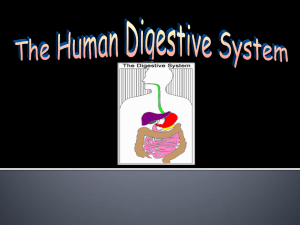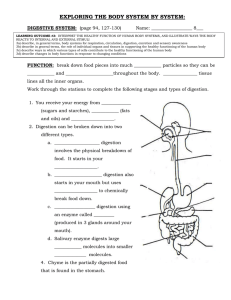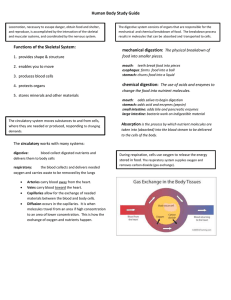Packet 13 Notes
advertisement
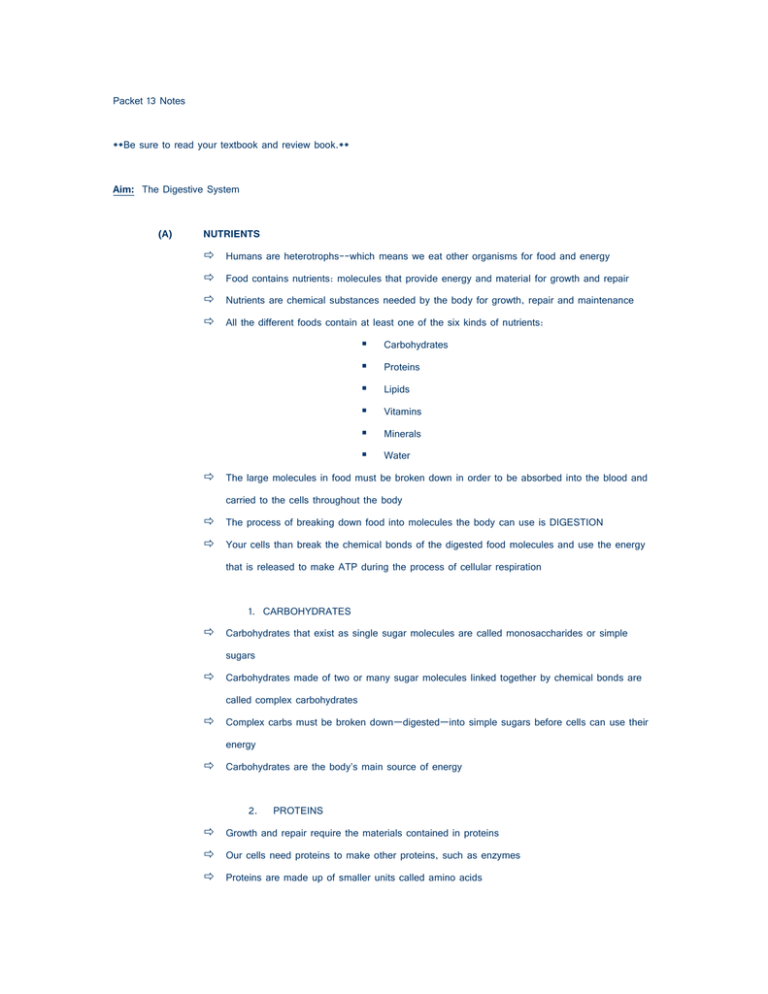
Packet 13 Notes **Be sure to read your textbook and review book.** Aim: The Digestive System (A) NUTRIENTS Humans are heterotrophs--which means we eat other organisms for food and energy Food contains nutrients: molecules that provide energy and material for growth and repair Nutrients are chemical substances needed by the body for growth, repair and maintenance All the different foods contain at least one of the six kinds of nutrients: Carbohydrates Proteins Lipids Vitamins Minerals Water The large molecules in food must be broken down in order to be absorbed into the blood and carried to the cells throughout the body The process of breaking down food into molecules the body can use is DIGESTION Your cells than break the chemical bonds of the digested food molecules and use the energy that is released to make ATP during the process of cellular respiration 1. CARBOHYDRATES Carbohydrates that exist as single sugar molecules are called monosaccharides or simple sugars Carbohydrates made of two or many sugar molecules linked together by chemical bonds are called complex carbohydrates Complex carbs must be broken down—digested—into simple sugars before cells can use their energy Carbohydrates are the body’s main source of energy 2. PROTEINS Growth and repair require the materials contained in proteins Our cells need proteins to make other proteins, such as enzymes Proteins are made up of smaller units called amino acids Most amino acids are made in the body, but there are eight essential amino acids which can only be obtained in the food we eat 3. LIPIDS AKA fat Although too much fat is not healthy, your body does need some fat Fat is important for: Another source of energy Protect our organs Make up cell membranes Help to insulate the body against changes in environmental temperature 4. VITAMINS Organic molecules that are needed by the body in very small amounts that serve as coenzymes They do not contain energy Most vitamins are enzyme helpers and play a role in cellular reactions 5. MINERALS Inorganic substances required the normal functioning of the body Many bodily functions rely on minerals We obtain minerals from the food we eat 6. WATER The most important nutrient Animals will die from lack of water long before they will starve from lack of food (B) BREAKING DOWN FOOD Before your body can use the nutrients in the food you eat, the large molecules must be broken down physically and chemically Digestion: the process of breaking down food into molecules the body can use The digestive system is the body system that is involved in the taking in and processing of food for use by your body cells The digestive system is made up of a long, winding tube, the digestive tract, that begins at the mouth and winds through your body to the anus The digestive tract includes the mouth, pharynx, esophagus, stomach, small intestine, large intestine, and rectum (C) STARTING DIGESTION three activities are involved in the digestive process: mechanical digestion—to break down food into tiny pieces without changing the chemical structure of the food chemical digestion—breaking down the food into smaller and smaller pieces so that the molecules can be absorbed into the bloodstream absorption—when the molecules are picked up by the blood and distributed to the rest of the body The digestion of food goes through the following path: 1. 2. 3. Mouth—digestion begins here some mechanical digestion—chewing some chemical—saliva—saliva contains salivary amylases which are enzymes that help break up the food Pharynx: where the food triggers a swallowing response—this moves the epiglottis over the trachea so the food does not enter the trachea Esophagus: a long narrow tube that connects the mouth to the stomach—no digestion occurs here—food is pushed down the esophagus by peristalsis: muscular contractions in the esophagus 4. 5. 6. 7. Stomach: saclike organ located just beneath the diaphragm—temporarily stores food and mechanically and chemically digests proteins Gastric juice—a combination of hydrochloric acid and pepsin—is located in the stomach Protected by a coating of mucus Small Intestine: coiled tubular organ that functions mainly in digestion and absorption—most of the absorption occurs here Fat is broken down here by a process called emulsification—bile breaks up fat globules into tiny droplets The lining of the small intestine is covered with fingerlike projections called villi which have cells called microvilli on their surface—this greatly increases the surface area available for absorption Large Intestine: wastes—component of food that aren’t used for energy— move into the large intestine Also known as the colon No digestion occurs here Most of the colon’s contents are dead cells, mucus, digestive secretions, bacteria, and yeast—also bacteria that make many compounds needed by the body Rectum: last part of the large intestine—wastes remain here until they are released though the anus (D) LIVER Secretes bile, which aids in the emulsification of fats Stabilizes blood sugar by converting extra sugar to glycogen for storage Breaks down the glycogen when needed for energy Can be damaged by viral infections, drug use, alcohol and traumatic injury (E) DISORDERS Diarrhea—watery feces—occurs when wastes are rushed through the large intestine before the remaining water is absorbed Constipation—hard feces—occurs when food remains in the colon for long periods of time, which causes too much water to be absorbed Ulcers—holes in the lining of the stomach—causes the acids to leak through

